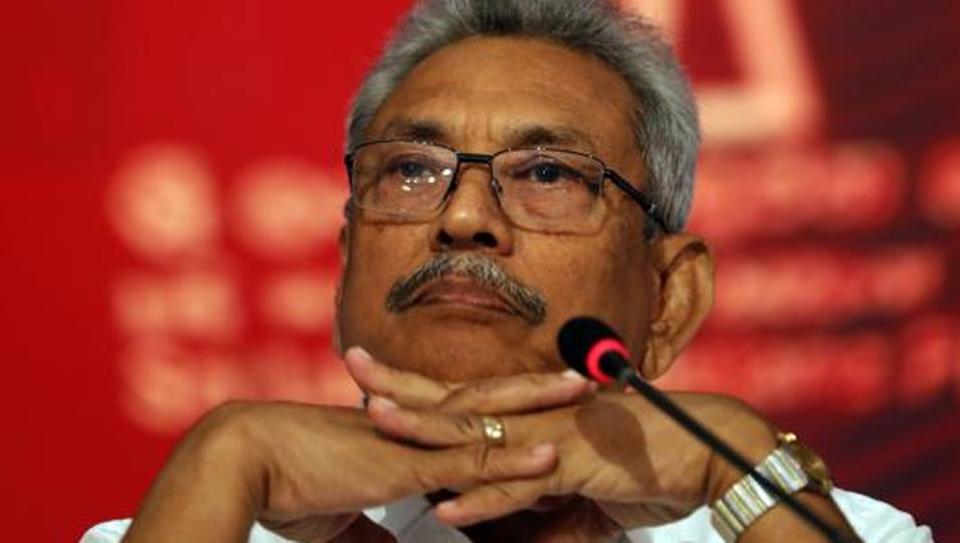Image courtesy of Hindustan Times.
It is now public knowledge and GR himself has accepted that his victory last year was entirely made possible by the overwhelming support he received from Sinhala Buddhists. However, behind this mass of Sinhala Buddhists was an army of supremacist foot soldiers under the command of militant members of the Sangha, who campaigned with communal hatred and religious zealotry to get GR elected so that they could achieve their Buddhist Valhalla.
GR is indebted to this army and commanders, and he wants to see that they work with the same gusto to achieve victory with a two-third majority for SLPP at the next General Election. GR, because of political necessity, has become a virtual prisoner of this group.
The political agenda of the supremacists goes far beyond protecting Sri Lanka’s unitary state, its sovereignty and constitution. The role of a militant clergy is totally outside the historic mission of bhikkus in this country, who in the past worked with the monarchs to ensure virtuosity in governance, without destroying the plural makeup of Sri Lankan society. Buddhism flourished as a result and the country prospered. These supremacists instead are essentially anti-democratic and anti-pluralist, and aspire to convert Sri Lanka into a homogenised nation with one religion, one culture, one law, and if possible, one race, all woven round their politicised Buddhism.
What do these supremacists want?
To achieve this objective they need an all-powerful president, protected by a loyal security machinery, a Prime Minister with less powers and a cabinet of ministers to carry out presidential orders. It is always easier to manipulate one person than to deal with an entire cabinet of ministers and members of their party. Hence, the need to change the constitution and do away with the 19th amendment. That could be done only with a two-third majority vote in the parliament, which the current caretaker government does not have.
Hence, the crucial importance of the coming General Election. With a two-third majority in parliament and with one brother as Prime Minister, the supremacist’s agenda would walk through easily for implementation. The big question is, does GR realise the hidden danger in this pernicious agenda and his own future if he fails to go along with supremacist demands.
For instance, GR’s rejection of power sharing with minorities by implementing the 13th amendment, which he agreed to do in front of the Indian Prime Minister in Delhi, but backed down after returning home and argued that the ‘majority’ was unwilling, shows PGR’s sad predicament. He did not say that he was not willing but the so called ‘majority’, and hiding behind that majority is the powerful supremacist minority.
It is this minority that also wants the national anthem sung only in Sinhala, and it is this minority that demands all madrasas be closed. When the Government decided to register the madrasas, militant bhikkus were up in arms criticising that move and demanded nothing less than total closure. GR is well and truly trapped into the supremacist net and once they secure him his desired two-third majority at the General Election they will have a stranglehold on the President. That is where the danger lies to the country and GR.
The militarisation
Supremacists’ relentless attack on the minorities cannot go on forever without provoking retaliation. It appears that even after a 30-year civil war and last year’s Easter massacre of colossal magnitude, both costing the country incalculable losses, these supremacists have not learnt their lessons. This may be the reason why GR has strengthened the security forces and its intelligence branch, through purge, promotions and recruitment. The decision to employ 100,000 young men and women from poor families also appears to have a military tinge.
His deployment of the military to all districts, in the name of turning ‘swordsmen into ploughmen’, is the soft face of militarising the country. He has to do this because he realises the danger of domestic convulsions arising out of supremacists’ reckless demands and lawless behaviour. If this continues unchecked the country will have no alternative but to become a police state, and that is not going to bring GR’s ‘prosperity and splendour’, but misery and mayhem.
What if GR rejects the supremacists?
What if GR rejects the supremacists? SWRD tried to do that in 1957 and paid with his life. Does the country want that history to repeat? SWRD was socialist minded and was not a born racist. He wanted to take the country on a new direction and took the cause of Sinhala language and Buddhism purely to win an election, and brought in the clergy to campaign for his victory.
“Here were the best election agents any politician could wish for – 12,000 men whose words were holy to over 5,000,000 people, campaigning for the downfall of the Government, zealously and, what is more gratis,” wrote the veteran journalist, Tarzi Vittachie (Emergency ‘58: The Story of the Ceylon Riots, London, 1958, p. 19). Once he took the genie out of the bottle he could not put it back.
Similarly, with a military background, an exposure to life in the democratic melting pot of USA, and with some grasp of how the Asian Tigers over the last few decades became economic power houses, Gota also wants to take Sri Lanka in a new direction for ‘prosperity and splendour’. He has plenty of constructive ideas and some of them have been translated into action already.
However, like SWRD, political necessity has made Gota also to fall into the hands of supremacists. He should be saved from their clutches, and the best way to save him is to deny the two-third majority he is looking for. Mother Lanka should feed her baby not with what the baby wants, but with what she thinks is best for the baby.
(The writer is attached to the School of Business and Governance, Murdoch University, Western Australia.)
The original longer version of this article was published in the Daily FT
